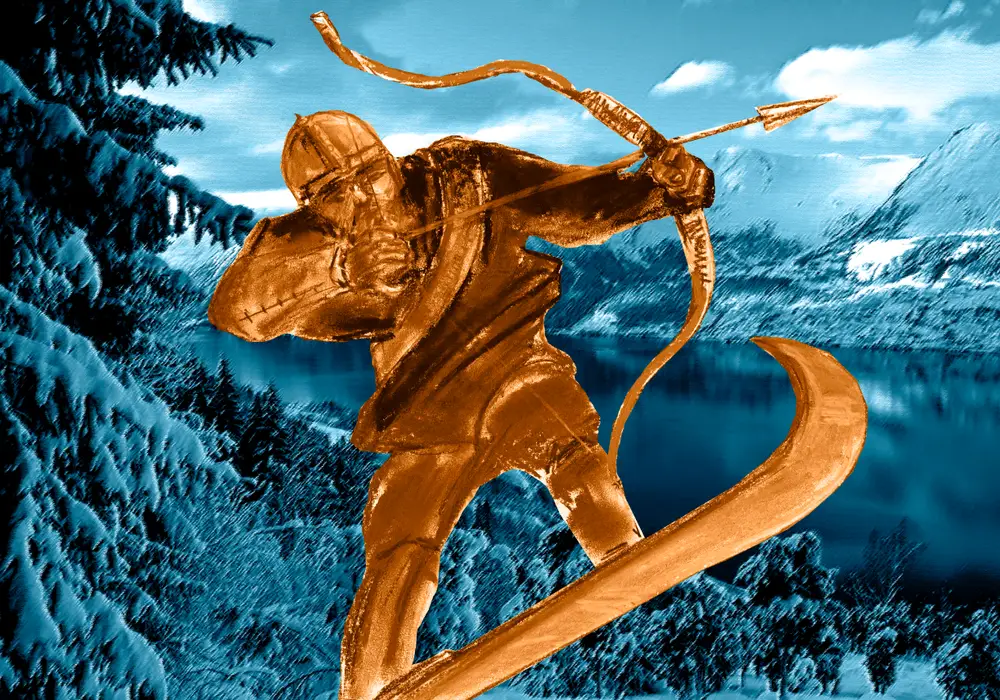Across the globe, there are many different gods and goddesses who act as personifications of snow and winter. Many cultures have their own snow deities, including China, Japan, and Greece. Lots of these gods and goddesses come from ancient myths and legends.
When the weather gets colder, it is natural to start thinking about these gods and goddesses. To help you pick a favorite snow deity, we have listed twelve of the best snow deities and explained who they are.

Ullr
First on our list is arguably the most famous snow deity, Ullr. Ullr has become the Norse god of snow. However, this god represents more than just snow, but also snow sports, skiing, and even archery. Ullr was said to be talented in these fields.
Throughout Europe, people believe Ullr to be the Patron Saint for Skiers. Many skiers even wear talismans depicting the god to gain his protection. In honor of this god, the ski town of Breckenridge in Colorado holds an annual “Ullr Fest.”
Held every January since 1963, this festival has people competing in events in order to encourage it to snow in the area.
Morana
This Slavic deity is known by many different names, including Morena, Marena, and Marzanna. This frightening goddess is associated with death and winter. If that was not scary enough, Morana appears as an ugly, old crone when witnessed by those who are afraid of her.
If a person is not afraid, however, this goddess becomes a beautiful and youthful woman.
In the countries Poland, Slovakia, Lithuania, and the Czech Republic, there is a ritual of drowning or burning an effigy of Morana. Representing the end of winter, this ritual is popular with children. Though she may seem sinister, Morana plays an important role in the natural world.
Cailleach
This goddess is sometimes referred to as Beira, Queen of Winter. In Gaelic mythology, Cailleach is an old hag who is responsible for creating some of the largest mountains and hills in Scotland. Accounts differ as to whether she intentionally or accidentally created these mountains.
Cailleach is said to have blue skin and white hair. She emerges on the 1st of February, attempting to make the winter last as long as possible. Cailleach does this by gathering firewood. This day is known as Saint Brigid's Day.
Boreas
Fourthly, Boreas is the Greek god of the cold north wind. In terms of appearance, Boreas is said to be winged and has a beard.
He is a powerful god with a short temper, meaning that you should not get on his bad side. This god is perhaps most famous for destroying the feet of the Xerxes, the Persian king.
Chione
Chione is the daughter of the previous god on this list, namely Boreas, and Orithyia of Athens. Chione is also linked to Poseidon, having mothered his son, Eumolpus. Chione herself was considered the Greek goddess of snow.
Khuno
Next up on our list is Khuno, the Incan god of snow. Bad-tempered, Khuno became annoyed when humans kept melting his snow and burning things to keep themselves warm. To punish humanity, he burned all the vegetation across the land.
The cocoa plant was all that remained, which humanity could use to warm themselves up. The message of this tale is that Khuno is not pleased when humanity melts snow and instead wants them to endure it.
Itztlacoliuhqui
In Aztec mythology, this difficult-to-pronounce deity is the god of snow, frost, punishment, and lifelessness. This deity was originally the god of dawn, called Tlahuizcalpantecuhtli.
After attempting to fire an arrow at the sun, Tlahuizcalpantecuhtli was disciplined by transforming him into Itztlacoliuhqui, god of the cold. This connection explains why dawn is often cold.
Depictions of this god show him holding a straw broom. This symbolizes his sacred duty of clearing away the dirt for new life to appear. Itztlacoliuhqui is also represented by a curved obsidian blade.
Tengliu
Next, we turn to Asian culture for Tengliu, the Chinese goddess of snow. Tengliu emerged in the Tang Dynasty. She has become an influential figure in Chinese culture.
Skadi
Returning to Norse mythology, Skadi is a goddess linked with skiing and winter. In Norse mythology, Skadi is an excellent hunter. Though her husband, Njörd, had a preference for being near the sea, Skadi preferred being near mountains.
This may explain why she is associated with skiing. Some people believe there to be a link between Skadi and Ullr, the Norse God who is similarly connected to snow and skiing.
Jack Frost
Jack Frost is one of the many forms of Old Man Winter, the personification of winter. Jack Frost is something of a villain, responsible for creating frosty weather and the impact it has on humans.
He has become a popular figure in Western culture, having been depicted in film, novels, and comics. Some of these representations characterize Jack Frost as more of a mischievous character and some even depict him as an outright hero.
Poli’ahu
It may surprise some people to learn that Hawaii, a tropical region renowned for its hot weather, has its own goddess of snow. Poli’ahu was enemies with Pele, the goddess of fire and volcanoes. According to legend, Poli’ahu held a sledding competition for mortals on Mauna Kea.
Poli’ahu was challenged by a beautiful woman. When Poli’ahu was winning the race, the mysterious woman revealed herself to be Pele.
This tale reminds us that these mountains were made from both fire and ice, two seemingly opposite elements. Even today, it is believed that Poli’ahu inhabits Kīlauea and Mauna Loa. In the winter period, she adorns the land with her beautiful snow.
Kuraokami
Last on this list is Kuraokami, a dragon. It might sound unusual to think of dragons, who are associated with fire, to be snow deities. Yet, this Japanese myth manages to provide such a deity. The god of snow and rain in Japanese legend, Kuraokami has a tragic but mythical origin.
Izanami, a creation goddess, died while giving birth to Kagu-tsuchi, a fire deity. As a result, Izanami’s husband murdered Kagu-tsuchi in an act of vengeance. Kuraokami was created from Kagu-tsuchi’s blood. Whenever there is rain or snow in Japan, Kurokami is said to be responsible.
Final Thoughts
When it comes to gods or goddesses related to snow, the cold, winter, and skiing, there are many to choose from. There is a diverse range of deities, coming from different cultures, regions, and periods in time.
Yet, each of these gods or goddesses has its own unique story and characteristics that make them distinct and interesting. Due to this, there is a snow goddess out there for everybody.
- How to Train in the Summer for Cross-Country Skiing: Off-Season Strategies for Peak Performance - April 19, 2024
- Ski Lift Ticket Prices in Colorado [For 2024 Season] - January 26, 2024
- How to Choose Classic Cross-Country Skis: A Guide for Beginners - November 10, 2023








